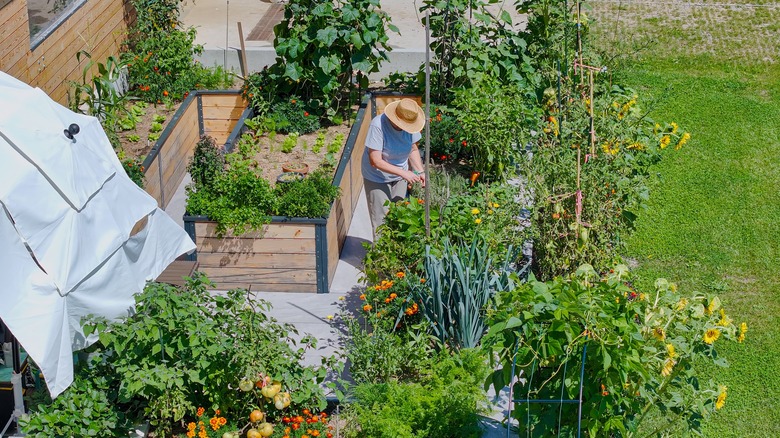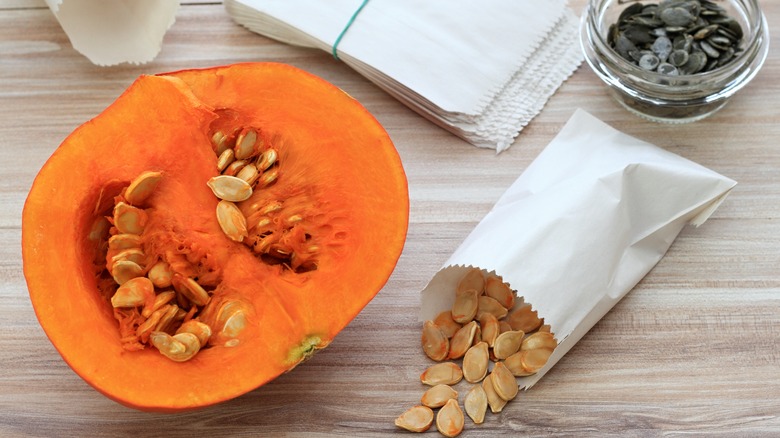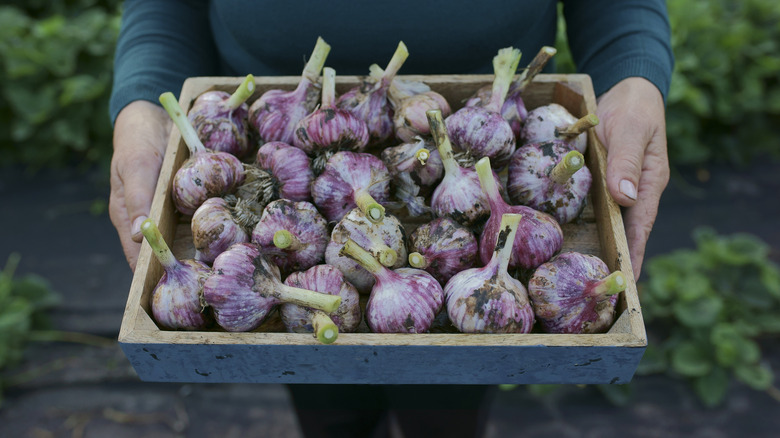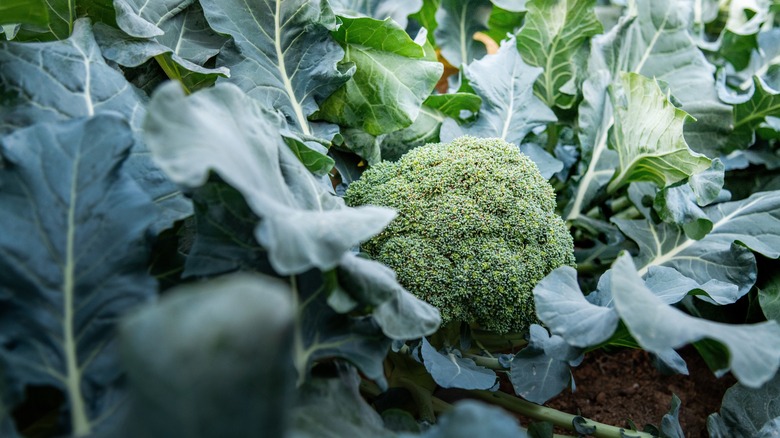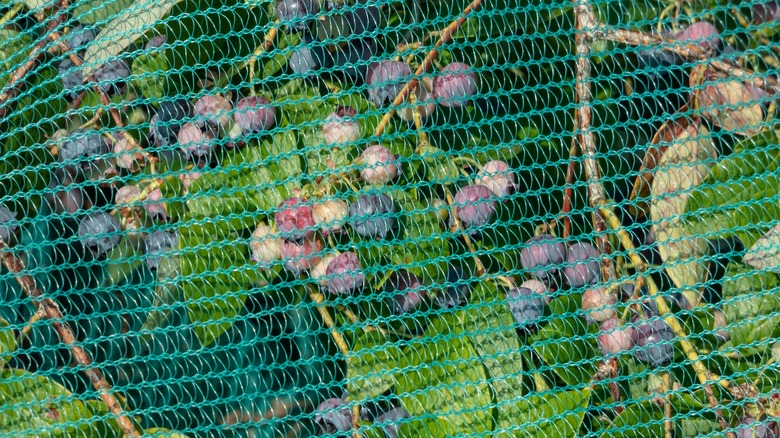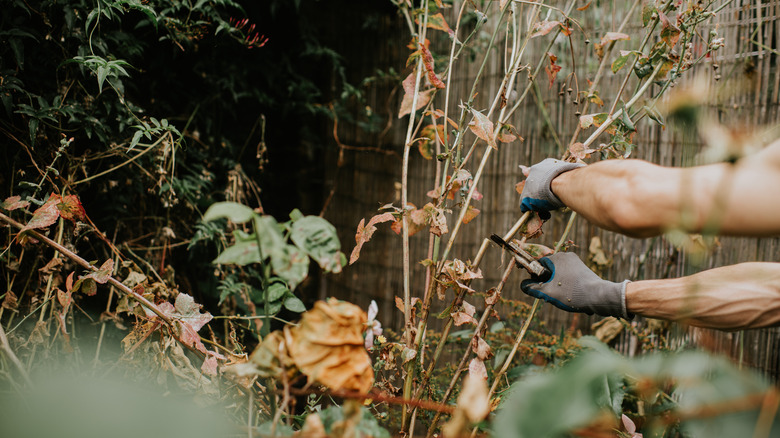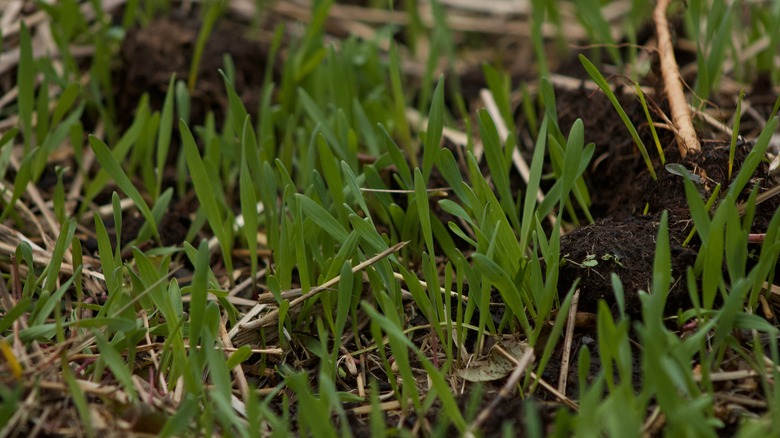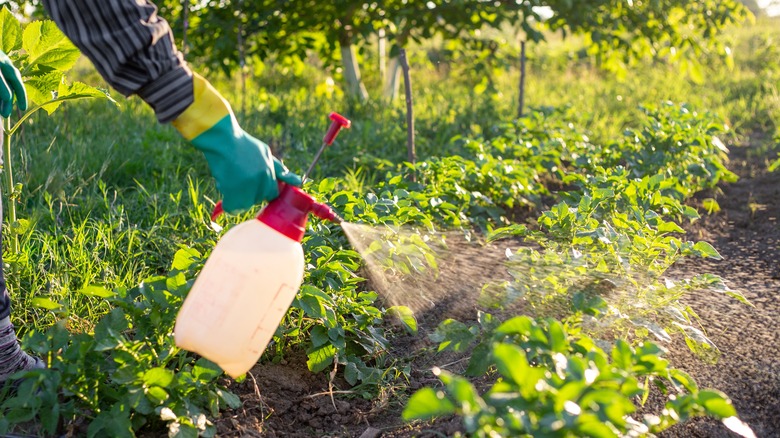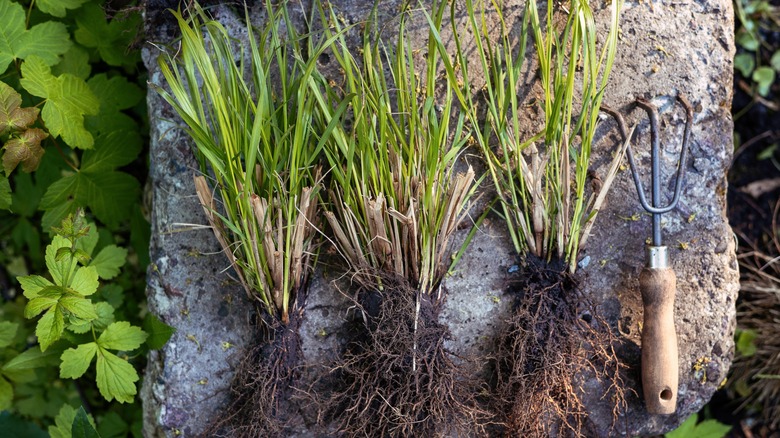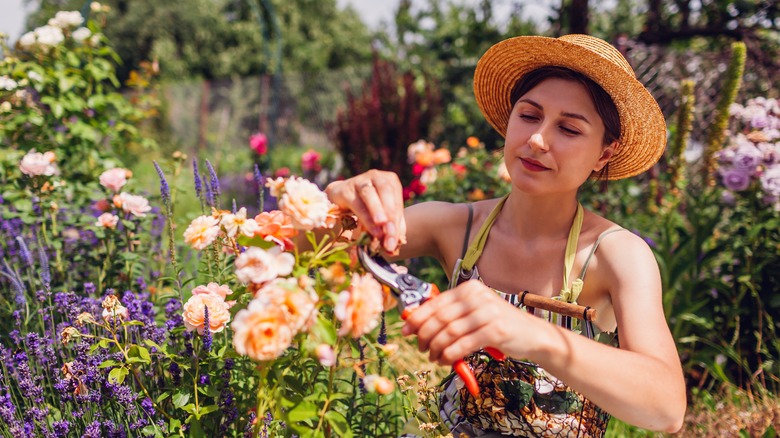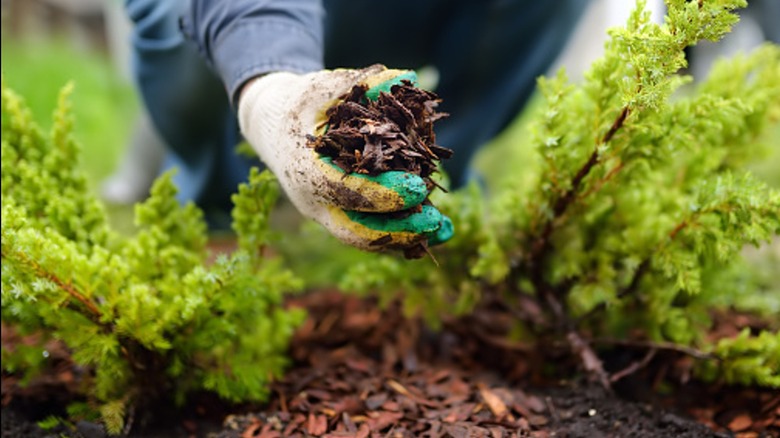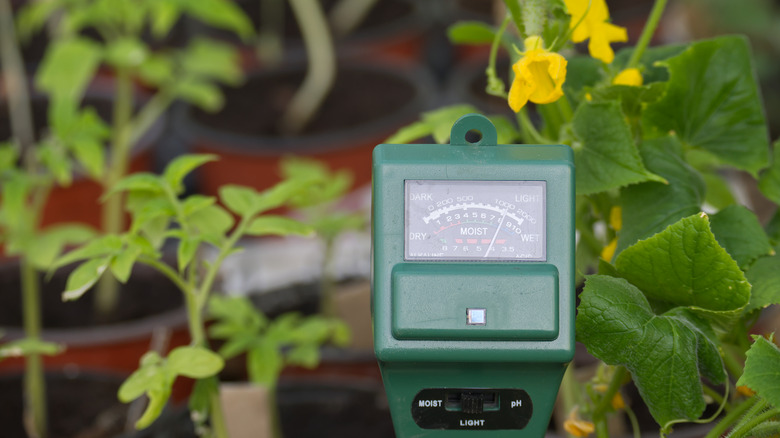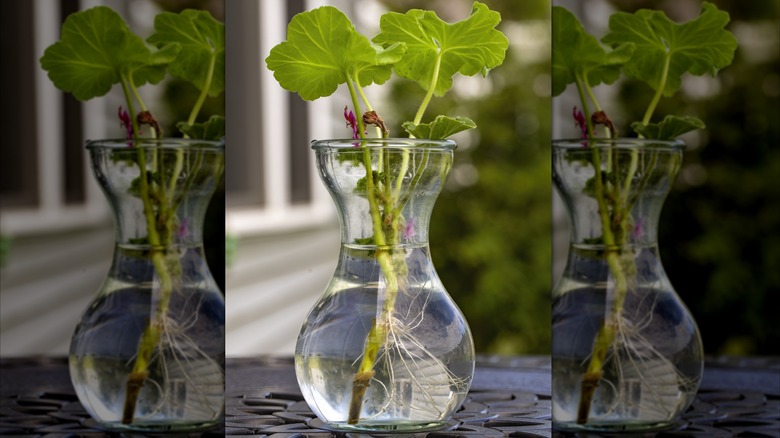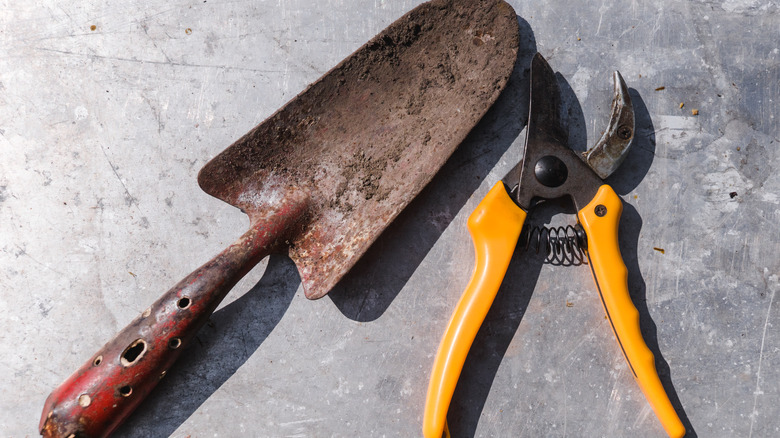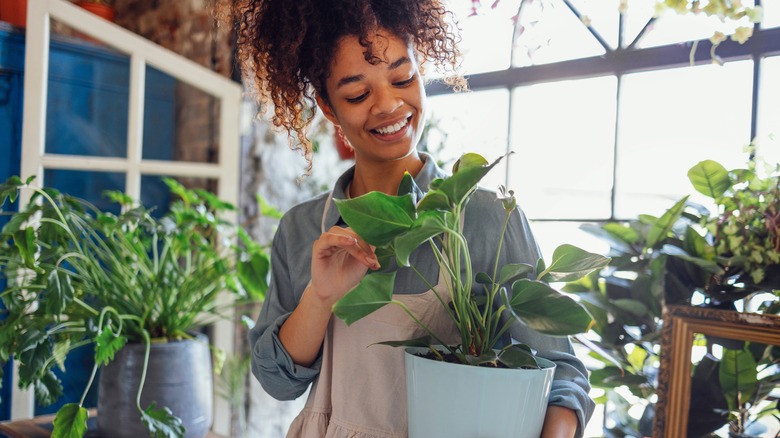17 Gardening Tasks To Do In August To Prepare For The End Of The Year
The August garden is the culmination of months of work. This time of year, you may be eyeing ripening tomatoes and winter squash, keeping up with prolific zucchini and beans, and controlling nature as best you can with watering and weeding. But every day brings you closer to transitioning your garden from summer to fall. There's also planning for the next growing season, while also maximizing your remaining time before the first frost.
With the bounty rolling in every day, it's easy to focus just on the immediate picking and preserving of fruits and veggies. However, it's also prime time to tackle projects for fall growth and prep for next year. Are there bushes getting unruly? Is the lawn looking lackluster? Do you spy a hint of downy mildew on those leaves? If you've got a bit of lag time between weeding and canning, squeezing a few of these tasks into your schedule will be well worth the time spent.
Collect and save seeds
August is the time to start your seed-saving journey. Stick with plants that are self-pollinating or non-hybrids for seeds that are easier to save and more likely to produce plants similar to their parents. For example, this time of year, your lettuce and other tender greens may be waving pods in the breeze. Pluck them off for saving. With a bit of patience, peppers, peas, and beans left to mature on the plant should also provide you with viable seeds. If you have a champion tomato plant, save a ripe fruit, and extract the seeds.
Order and plant bulbs and perennials
Start thinking of spring once you turn the calendar page to August. It's not too early to get a few bulbs like tulips, daffodils, and snowdrops into the ground for a colorful spring garden. Place orders for other bulbs to plant in a month or so, such as alliums, irises, lilies, and hyacinths. Some perennial plants like echinacea and coreopsis are also good to plant in August; they'll have just enough time to settle in and establish roots to overwinter successfully.
Plant cool season crops
Just because the first frost is around the corner, it doesn't mean that you'll have to put your garden to bed once it happens. Vegetables like beets, carrots, broccoli, and cabbage can all make it through a cold snap for a late fall harvest. You probably won't have had fresh garden lettuce in months, so why not get a few seeds started indoors for sweet eating once things cool off? There are a few herbs you can plant in August too, like dill, parsley, and cilantro.
Protect your plants
There's little that's more frustrating than watching a crop get munched by an animal when it's just days away from harvesting. Protective coverings around plants can keep critters at bay, so put them in place for your fall garden in August. Netting or wire mesh are common choices, but if you're up for something new, try this genius gardening hack that lets pollinators in but keeps squirrels out.
Remove dead plant matter
Take a bit of time to trim away dead leaves and pick up any fallen fruits or vegetables littering your garden beds. Not only are they ugly to look at, removing dead leaves and fruit also prevents pests from settling in and discourages diseases. Clearing away dead material can also improve air circulation and productivity. If you have plants that are done producing for the year, like peas or bolted lettuce you've already hit up for seeds, pull them out since they can also bring insects and diseases.
Plant cover crops
Once you've cleared out any plants that are finished for the season, getting a cover crop going in empty spots is a good idea. Plants like oats, hairy vetch, forage pea, and types of rye all help preserve and revive the soil over winter. These cover crops prevent erosion from winter wind, and they can also restore nutrients to the soil and improve its structure for the next season.
Treat for pests and diseases
Don't let bugs or diseases derail your months of hard work! August can bring aphids, Japanese beetles, spider mites, and tomato hornworms with it. The summer heat and humidity also help diseases spread and worsen. You can hand-remove some pests, but there are some decent non-toxic remedies that are worth trying. Neem oil is a go-to for pest control, and luring in ladybugs and/or lacewings can protect your garden. Prevent mildew and leaf spot by not watering the leaves. If it's too late, remove the affected leaves and treat with a fungicide if necessary.
Divide perennials
Dividing your perennials is a win-win: You get new plants for free, and they grow better with room to spread out. In August, dig into your coneflowers, coreopsis, daylilies, irises, bee balm, and phlox. If these flowers are still blooming in your area, hold off; divide plants when they're not flowering so that the energy can go into leaf and root production. You can tell a plant could use a split if it's not flowering well, if there's a gap in the center of the foliage, or if the foliage around the base is sparse.
Lawn care
If you haven't yet committed to a grass alternative for your lawn, August is a good time to give your weary lawn attention. If you didn't do so in the spring, aerate the grass. Try a cheap DIY lawn aerator that's nothing more than a piece of wood and long nails. Give it a dose of slow-releasing balanced fertilizer, too. If you're noticing patches of dead or thin grass, reseeding or adding a bit of new sod is a smart choice in August, especially once the kids are back in school!
Deadheading
Like weeding, deadheading is one of those ongoing summer to-do list items, but an extra August round can encourage a final flush of blooms for the summer. If you're deadheading faded flowers that require snippers rather than hand-pinching, make sure the blades are clean and sharp before diving in. However, if you have coneflowers, black-eyed susans, or other self-seeding plants, consider leaving a few heads intact so that the seeds will spread and grow for next year.
Refresh mulch
With so many edibles in season, you're probably putting all of your efforts into harvesting and watering. But taking time for a mulch refresh can save you work later by holding in moisture and suppressing weeds. August sun still pumps out lots of heat, so it's wise to opt for light-colored mulch to keep the ground from overheating. Also, limit the mulch's thickness to 2 to 3 inches so that the roots can still benefit from adequate air circulation.
Pruning
Just like deadheading flowers and harvesting vegetables, removing extra plant material saves the plant energy that's better spent putting out new fruit or veggies. However, not all plants and all climates are appropriate for August pruning. If your growing season is short, pruning could encourage new growth that won't have enough time to develop before the first frost. In general, you can take on very light pruning now. Safe options are lavender, rosemary, tomatoes, and caneberries, like raspberries or boysenberries.
Soil testing
Have you had a soil sample tested this season? Especially after several months of pumping out nutrients to plants, your soil could use a test at this time to help you plan for next year and determine any amendments you'll need to make. You can purchase home soil testing kits at home improvement stores or online. You can also send in samples to a soil testing lab, typically available at state universities' extension offices.
Take cuttings
Save money and time by prepping some plants for propagation over winter. Flowers like impatiens, coleus, geraniums, and wax begonias might be too bulky to dig up and bring inside for the winter, so propagation is a money-saving way to enjoy the same plants next summer. If you're hurting for space for all of these cuttings, set up a vertical arrangement by turning an IKEA spice rack into a propagation station.
Clean tools
By this time in the growing season, your tools have gotten a lot of use. Chances are they haven't had a good cleaning in a while. With all the digging and clipping going on, they may have come into contact with diseases that you certainly don't want to spread. Clean and disinfect your gardening tools with a soap and water bath first, then sterilize them with a mixture of water and a product like bleach or rubbing alcohol.
Repot houseplants
Even though your houseplants aren't subjected to the whims of seasonal weather, they still go through natural growing cycles. The summer is a time of growth for them, too, so if they're looking a bit cramped, repotting in August is good form. Handle the bare plants carefully, and untangle any roots if the plant is rootbound. Rehouse them to larger, clean pots with fresh soil. Make sure the root ball lines up with the lip of the new pot.
Planning for next year
As the growing season nears its end in many places, it's high time to reflect on what you planted, what grew well, what grew where, and any hurdles you encountered over the summer. If you don't currently have a method of keeping garden notes, August isn't too late to start. Whether it's a paper journal or document saved on your computer or phone, keeping track of these details can help you make plans for the upcoming season, like which brands of seeds to buy or where to rotate plants for soil health.
